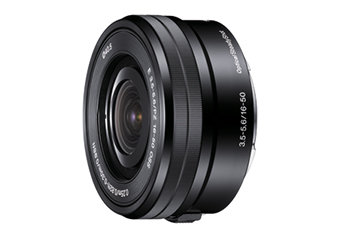Sony E PZ 16-50mm f/3.5-5.6 OSS Lens
SKU # son.SELP1650.blk
$298.00
Regular price
$298.00
$298.00
Sale
Thanks to its clever retracting mechanism, this zoom lens collapses to just 3/16in making it the perfect choice for on-the-go shooting when a compact, lightweight lens is ideal.
SELP-1650 retractable zoom lens is super compact and easy to carry so you can quickly whip out your camera and spontaneously grab shots as they occur. It's perfect for traveling and other scenarios that require a lightweight, compact camera and lens combo. It covers a 16 mm to 50 mm range for flexible shooting, and is equipped with one ED (extra-low dispersion) and four aspherical elements, resulting in a high-performance lens that is surprisingly compact.
- Built-in Optical SteadyShot image stabilization
- Filter Size 40.5 mm
- Length 1.2 in
- Weight 4.1 oz
- Minimum Focus Distance 9.8 Inches (measured from image sensor)
- Lens Aperture f/3.5-5.6 Maximum f/22 - f/36 Minimum
To use this lens in Nauticam housings, use Nauticam #36172 Lens Gear for Sony 16-50mm Power Zoom and Nauticam Macro Port 45 With Focus Knob.
The lens alone will fit in the standard Nauticam Port 45, but the power zoom function will be unavailable.
Circular Aperture
When changing your aperture to defocus the background, the light sources appear blurred. This 'bokeh' effect of the blurred background can be enhanced with circular aperture blades used in this lens. Conventional aperture blades have flat sides creating unappealing polygonal shaped defocussed points of light. α lenses overcome this problem through a unique design that keeps the aperture almost perfectly circular from its wide-open setting to when it is closed by 2 stops. Smoother, more natural defocusing can be obtained as a result.
ED (Extra-low Dispersion) glass
As focal lengths get longer, lenses built with conventional optical glass have difficulties with chromatic aberration, and as a result images suffer from lower contrast, lower color quality, and lower resolution. ED glass dramatically reduces chromatic aberration at telephoto ranges, and provides superior contrast across the entire image, even at large aperture settings. Super ED glass provides enhanced compensation for chromatic aberration.
Aspherical lens elements
Aspherical lens design dramatically reduces spherical aberration while also reducing lens size and weight. Spherical aberration is a slight misalignment of the light rays projected on the image plane. This is caused by differences in refraction at different points on conventional spherical lenses which degrade image quality in large-aperture lenses. Specially shaped "aspherical" elements near the diaphragm restore alignment of light rays at the image plane, maintaining high sharpness and contrast even at maximum aperture and can also be used at other points in the optical path to reduce distortion. Well-designed aspherical elements can reduce the total number of elements required in the lens, thus reducing overall size and weight. Advanced Aspherical (AA) elements are an evolved variant, featuring an extremely high thickness ratio between the center and periphery. AA elements are exceedingly difficult to produce, relying on the most advanced molding technology to consistently and precisely achieve the required shape and surface accuracy, resulting in significantly improved image accuracy and quality.
Distance encoder
The distance encoder plays an integral part in ADI flash metering, which delivers high precision flash metering that is unaffected by the reflectance of subjects or backgrounds. The distance encoder is a lens component that directly detects the position of the focusing mechanism, and sends a signal to the CPU in order to measure distance to the subject. During flash photography, this data is very useful in calculating how much flash output is appropriate to the scene.
Lens-based optical image stabilization
Gyro sensors built into the lens detect even the slightest movement, and the stabilization lens is precisely shifted to counteract any image blur that might occur. The use of precision, quiet linear motors and technology inherited from high-end Sony professional camcorders results in exceptionally quiet, effective image stabilization that contributes to high-quality movies as well as stills.
Internal focusing
Only the middle groups of the optical system move to achieve focus, so the overall length of the lens does not change. Other important benefits include fast autofocusing and a short minimum focusing distance. Also, the filter thread at the front of the lens does not rotate, which is convenient if you're using a polarizing filter.

